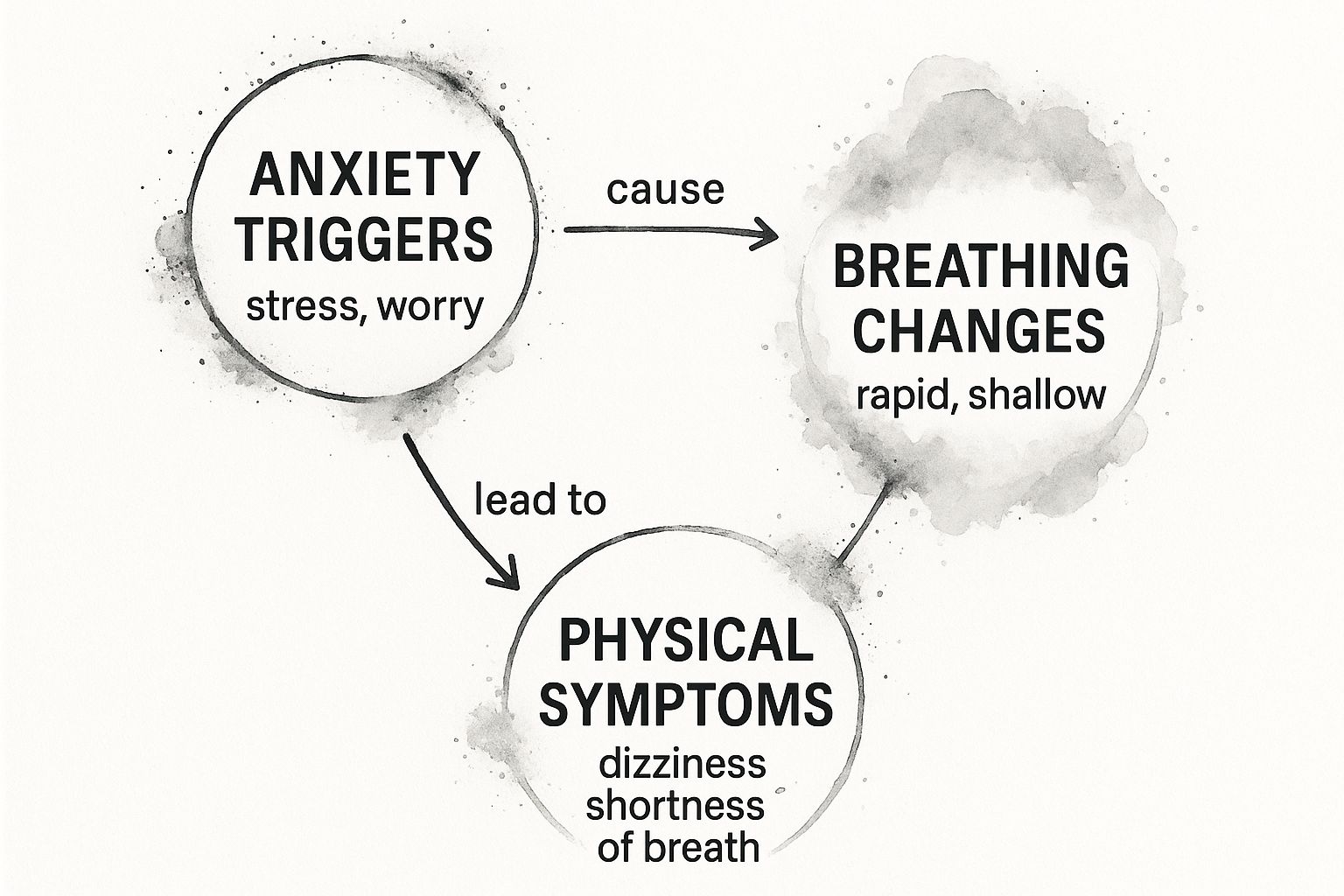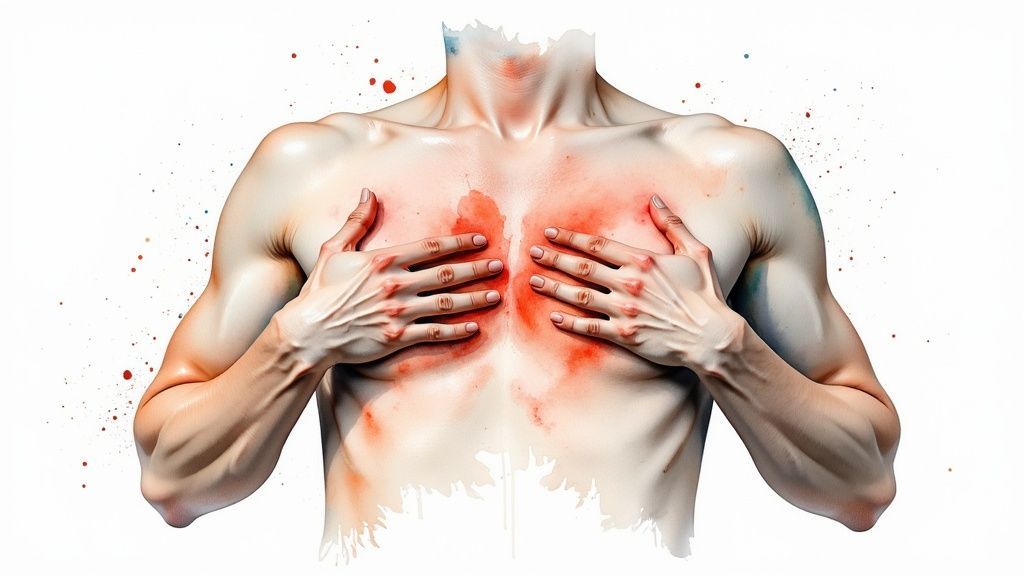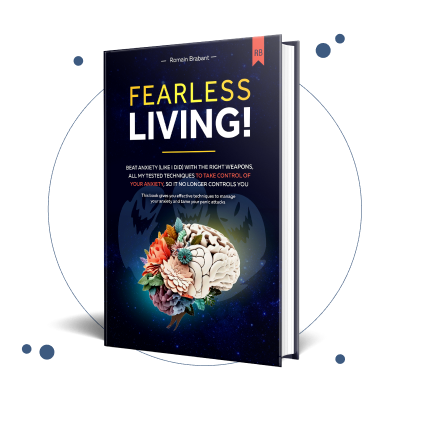
Yes, anxiety can absolutely cause breathing problems, and if you’ve felt that terrifying tightness in your chest or the sensation that you just can't get a full breath, you are not alone. More importantly, this feeling is not a life sentence.
There's a very real biological reason for it, and understanding what’s happening in your body is the first, powerful step toward healing and living a life free from panic.
Your First Breath of Relief: Understanding the Connection
That sudden, scary feeling of not getting enough air is one of the most common physical symptoms of anxiety. It can be terrifying, often making you wonder if something is seriously medically wrong.
The truth is, your body is simply reacting to a perceived threat, kicking its ancient "fight or flight" system into high gear. This response is designed for survival, but when it’s triggered by anxious thoughts instead of an actual lion in the bushes, it creates profoundly uncomfortable physical sensations.
Your breathing becomes rapid and shallow—a process called hyperventilation. This isn't your body failing; it's your body trying to protect you by loading up on oxygen, getting you ready to either fight the threat or run from it.
The Biological Mix-Up
When you hyperventilate, you throw off the delicate balance of oxygen and carbon dioxide in your blood. It’s this chemical shift that leads to dizziness, tingling in your hands and feet, and that awful, suffocating feeling of "air hunger."
The good news? You are not in any real danger, and this is a cycle you can learn to break. You are definitely not alone in this experience. Anxiety disorders are incredibly common, affecting millions of people all over the world.
Research shows that anxiety disorders impact roughly 4.4% of the global population, which is about 359 million people. These conditions often trigger physical responses like shortness of breath by activating the body's 'fight or flight' mechanism. You can learn more about the global prevalence of anxiety and its symptoms.
This infographic breaks down how an anxious thought can set off a powerful chain reaction in your body, leading directly to those breathing changes.

As you can see, a simple worry can kickstart a cascade of physical symptoms.
Understanding this connection is the key to breaking the cycle. When you can recognize these symptoms for what they are—a false alarm from your nervous system—you can start to shift from fear to empowerment. This knowledge is the foundation for learning techniques to calm your body and mind, proving to yourself that you can regain control.
Anxiety Breathing vs. Medical Breathing Issues: A Quick Guide
It’s completely normal to worry if your shortness of breath is a sign of something more serious. While you should always consult a doctor to rule out medical issues, this table can help you spot some of the common differences between anxiety-related breathing and other potential problems.
| Symptom Profile | Anxiety-Related Breathing | Potential Medical Breathing Issue |
|---|---|---|
| Onset | Tends to come on suddenly, often during moments of high stress or panic. | Can develop gradually or suddenly, and may not be linked to your emotional state. |
| Accompanying Symptoms | Often comes with other anxiety signs like a racing heart, sweating, trembling, or a sense of doom. | May be accompanied by symptoms like coughing, wheezing, fever, or chest pain that feels different from anxiety. |
| Triggers | Usually triggered by specific fears, stressful situations, or anxious thought patterns. | May occur without any clear emotional trigger, such as during physical exertion or while lying down. |
| Duration & Resolution | Symptoms typically peak within 10-20 minutes and subside as the anxiety or panic passes. | Can be persistent or recurring over a longer period, not necessarily resolving when you feel calm. |
| Response to Calming | Breathing often improves with relaxation techniques, deep breathing exercises, or distraction. | Symptoms may not improve with relaxation and might require medical intervention. |
Remember, this is just a guide. If your breathing problems are persistent, severe, or accompanied by symptoms like chest pain, fainting, or swelling in your legs, it’s crucial to seek professional medical advice right away. Your peace of mind is what matters most.
Why Your Body Triggers a False Alarm
Imagine your body has a top-of-the-line, ultra-sensitive smoke detector. It’s designed to keep you safe, but with anxiety, that alarm can go off at the slightest hint of smoke—sometimes just from the thought of a fire, long before there’s any real danger. This is the best way to understand why anxiety can mess with your breathing.
Your brain picks up on a perceived threat. It could be a passive-aggressive email from your boss, navigating a crowded grocery store, or even just a random, intrusive worry. Whatever the trigger, your brain sounds the alarm. This isn't a glitch; it's your body's ancient, hardwired survival mechanism known as the fight-or-flight response. This system is built to get you ready to either face down a predator or run for your life.

The moment that alarm sounds, your body gets a massive jolt of adrenaline. Think of it like a shot of rocket fuel. Your heart starts hammering in your chest, pumping oxygen-rich blood to your muscles so you can react fast. That's why you feel that sudden, racing pulse.
The Adrenaline Rush and Your Lungs
To get all that extra oxygen into your bloodstream, your breathing automatically kicks into high gear. You start taking quick, shallow breaths from your chest instead of the deep, slow breaths that come from your belly. This rapid breathing is called hyperventilation.
Here’s the hopeful part: there's no actual lion to fight or flee from. You might just be sitting in traffic or trying to fall asleep, but your body is prepping as if it's about to sprint a marathon.
This is the exact moment when the breathing trouble starts. Hyperventilating can feel like you’re not getting enough air, but in reality, you’re taking in too much oxygen, way too fast. This throws off the delicate balance of gases in your blood, specifically causing your carbon dioxide levels to drop.
“When you feel anxious, your brain perceives a threat. To prepare your body to either confront or escape danger, the fight-or-flight response releases large amounts of adrenaline and other chemicals into your body.”
This chemical shift is what triggers some seriously scary physical sensations:
- Dizziness and Lightheadedness: That change in blood gases can make you feel unsteady, like you’re about to faint.
- Tingling Sensations: You might feel a pins-and-needles sensation or numbness in your hands, feet, or face.
- Chest Tightness: The muscles in your chest clench up, making it feel like something is squeezing you and you can’t get a full breath.
- A Feeling of Suffocation: Paradoxically, breathing too much, too fast, creates the terrifying sensation that you can’t breathe at all.
This entire chain reaction is automatic and can unfold in seconds. To get a deeper dive into this incredible biological process, check out our complete fight-or-flight response guide.
Just understanding this mechanism is a huge first step toward feeling better. It proves your body isn’t broken or failing you. It’s actually a sign that your protective instincts are just working a little too well. Armed with this knowledge, you can start teaching your body that the alarm is false and reassuring your nervous system that you are safe. This isn't a life sentence; it’s a pattern you can absolutely change.
Learning to Recognize Anxiety's Breathing Patterns
Anxiety-driven breathing problems are more than just a vague feeling of being out of breath. They show up in specific, often terrifying ways that can convince you something is terribly wrong. Learning to identify these patterns for what they are—physical symptoms of anxiety—is a powerful step toward reclaiming control.

Many people know the frustrating feeling of "air hunger." It’s that constant, nagging sense that you just can’t get a satisfying, deep breath. No matter how hard you try to inhale, it feels like your lungs won't fill up completely, leaving you in a state of perpetual discomfort.
This sensation is a direct result of your body's alarm system being stuck in the "on" position. Chronic, low-level stress keeps your breathing muscles, like the diaphragm, in a constant state of tension, making a full, relaxed breath feel almost impossible.
Common Signs of Anxiety-Related Breathing
Spotting these specific symptoms can help demystify what you're feeling. Instead of a random, scary event, you can start to see a predictable pattern tied directly to your anxiety levels. This is a crucial shift that empowers you to respond differently.
Here are a few common ways anxiety messes with your breathing:
- Frequent Sighing or Yawning: You might find yourself sighing heavily or yawning over and over again. This is your body's subconscious attempt to reset its breathing and draw in more air, trying to correct the oxygen-carbon dioxide imbalance.
- A Feeling of Smothering: This is the frightening sensation that you’re suffocating or that something is physically blocking your airway. While it feels incredibly real, it’s often caused by hyperventilation and muscle tension in the throat and chest.
- Chest Tightness or Pressure: The muscles around your rib cage can clench so tightly during an anxiety response that it can mimic the feeling of a heart attack. This pressure makes it feel physically difficult to expand your lungs for a proper breath.
These patterns are especially common during high-stress moments and can escalate quickly into a full-blown episode. To understand this better, it helps to explore the anatomy of a panic attack.
The key takeaway is this: these breathing patterns, however frightening, are not dangerous. They are the predictable outcome of a nervous system stuck on high alert. Recognizing them is the first step to breaking the cycle.
By learning to identify your personal patterns—whether it's air hunger after a stressful meeting or chest tightness when you feel overwhelmed—you create a critical space between the sensation and your reaction. In that space, you can choose to use a calming technique instead of spiraling into more fear. This awareness is where the journey to a panic-free life truly begins.
When to Get a Medical Checkup for Peace of Mind
That nagging thought, “What if this time it’s not anxiety?” is a heavy burden to carry. But facing that worry head-on is one of the most empowering steps you can take on your path to healing.
Getting a medical checkup isn’t a sign of weakness; it’s a smart, proactive move. It gives you the certainty you need to finally tackle your anxiety with total confidence.

Think of it like securing the foundation of a house before you start decorating. By confirming that your physical health is solid, you can shut down the cycle of health-related worry. This frees up your energy to focus on the real source of your breathing issues—the anxiety itself.
This clarity is a powerful gift to give yourself.
Ruling Out Other Possibilities
A thorough checkup lets a doctor rule out other potential culprits for breathlessness, like asthma, heart conditions, or certain deficiencies. It’s not uncommon for symptoms that mimic anxiety—shortness of breath, racing heart, fatigue—to stem from something else entirely. For this reason, it's wise to assess your ferritin and iron levels during your visit.
This step becomes even more critical if you already have a health condition, as anxiety can pour fuel on the fire.
For instance, research shows that in chronic respiratory diseases like COPD, anxiety is a huge factor linked to worse breathing outcomes. In fact, COPD patients are 85% more likely to develop anxiety disorders, leading to more severe breathlessness and even more hospital visits.
The Power of Certainty in Your Healing Journey
Once you have that medical reassurance—the confirmation that your heart and lungs are healthy—the whole game changes.
Suddenly, that frightening shortness of breath loses its power. You can start to reframe the sensation not as a sign of imminent danger, but as a known symptom of anxiety. It's a false alarm you can learn to manage and eventually silence.
This peace of mind gives you the solid ground you need to begin your recovery. It allows you to fully commit to anxiety management techniques without that constant fear that you're overlooking a "real" medical problem.
For some, this might also mean working with a mental health professional for a clear diagnosis and treatment plan. If you're considering this path, learning more about the role of a psychiatrist for anxiety can be a helpful next step. When you take care of both your physical and mental health, you build a powerful, comprehensive strategy for a calmer, panic-free life.
Practical Ways to Get Your Breath Back
Finally understanding why anxiety messes with your breathing is a huge first step. But the real magic happens when you have a go-to toolkit to handle it in the moment. This is where you learn to do more than just “take a deep breath.” You’re about to get a clear path to reclaiming control and proving to yourself that you’re in charge—not the anxiety.
The goal isn't to wrestle with the sensations. It's about gently calming the alarm system that's firing off false signals. With a little practice, you can actually retrain your body’s default response, turning your breath from a source of fear into an anchor of calm. These techniques are your first steps toward that freedom.
Diaphragmatic Breathing: The Nervous System Reset
When you’re anxious, your breathing gets shallow and stuck up in your chest. Diaphragmatic breathing, also known as belly breathing, is the perfect antidote. It directly stimulates the vagus nerve, sending a powerful message straight to your brain to pump the brakes on the fight-or-flight response.
Think of it like flipping a switch from "panic mode" to "calm mode." Here’s how you do it:
- Get Comfortable: Lie down or sit up straight. Place one hand on your chest and the other on your stomach, right below your rib cage.
- Breathe In Slowly: Inhale gently through your nose for a count of four. As you breathe in, focus on letting your belly expand like a balloon. The hand on your stomach should rise, while the one on your chest stays pretty still.
- Breathe Out Slowly: Exhale softly through your mouth for a count of six. Feel your belly gently fall as the air leaves your body.
- Repeat: Keep this rhythm going for a few minutes. Try to put all of your focus on the simple sensation of your belly rising and falling.
This simple act communicates a profound sense of safety to your nervous system. For a deeper dive into this and other powerful methods, check out our guide on breathing exercises for anxiety.
The 4-7-8 Breathing Method
Developed specifically as a tool for deep relaxation, the 4-7-8 method is a structured breathing pattern that can stop a rising sense of panic in its tracks. The rhythm helps regulate your heartbeat and gives your racing mind a simple, singular focus.
This technique is so effective because it forces you to make your exhale longer than your inhale—a key trigger for your body's relaxation response. It's a powerful tool you can pull out anywhere, anytime.
Grounding Exercises and Simple Lifestyle Shifts
Sometimes, the best move is to yank your focus away from the scary physical feelings altogether. Grounding exercises are perfect for this, anchoring you firmly in the present moment. A great one to try is the 5-4-3-2-1 technique:
- 5: Name five things you can see around you (a lamp, a crack in the wall, your own hands).
- 4: Acknowledge four things you can feel (the floor under your feet, the fabric of your shirt).
- 3: Listen for three things you can hear (a distant car, the hum of a fan, your own breathing).
- 2: Identify two things you can smell (coffee, soap, fresh air).
- 1: Name one thing you can taste (your last meal, mint from toothpaste).
Beyond these in-the-moment tools, building long-term resilience comes down to simple lifestyle shifts. Mindful movement like a slow walk or gentle yoga helps release pent-up physical tension. Also, keeping an eye on stimulants like caffeine can dramatically lower your baseline anxiety, making your nervous system far less likely to sound a false alarm in the first place. Every small change builds a stronger foundation for a calmer you.
Your Path Forward to a Panic-Free Life
Dealing with anxiety symptoms in the moment is crucial, but true freedom comes from healing the roots of your anxiety. This is your journey toward long-term recovery, and I want you to know it’s completely possible. Your breath can become an anchor for calm again, not a trigger for panic.
Proven methods like Cognitive Behavioral Therapy (CBT) are designed to help you rewire the very thought patterns that set off your body’s false alarms. You learn to spot and challenge the anxious thoughts that snowball into physical symptoms. It’s not about erasing anxiety from your life forever—it's about building the confidence and skills to face it without fear, knowing you have the tools to navigate it.
Building Your Foundation for Lasting Calm
True recovery isn’t just about techniques; it’s about building a life that supports your mental well-being from the ground up.
A strong support network—friends, family, or professionals who get it—is incredibly grounding. Just as important is learning to be kind to yourself. Practice self-compassion, give yourself grace on the tough days, and don't forget to celebrate the small wins. They all add up and pave the way to a more peaceful life.
The ultimate goal is empowerment. Recovery means you are in charge—not the anxious thoughts. It’s knowing you can handle whatever comes your way, turning that overwhelming fear into a manageable feeling that no longer controls your life or your breath.
Beyond the immediate strategies, it's about creating habits that soothe your nervous system. A well-rested mind, for instance, is far more resilient. To explore this further, you can understand the role of sleep as an emotional anchor.
Taking these steps helps you build a full, vibrant life where you feel safe and in control again. If you're looking for a structured way to get there, take a look at these essential anxiety recovery steps that can guide you toward lasting peace.
Your Questions About Anxiety and Breathing, Answered
When you're struggling to catch your breath and suspect anxiety is the culprit, questions pop up left and right. Getting clear, straightforward answers is one of the first steps toward feeling safe and back in control. Let's tackle some of the most common ones.
Can Anxiety Really Cause a Constant Shortness of Breath?
Yes, absolutely. Chronic anxiety can leave you with a persistent, nagging feeling that you just can’t get enough air. It's often called “air hunger,” and it’s incredibly common.
When your nervous system is stuck in high-alert mode, it subtly changes your breathing patterns. You might start breathing from your upper chest without even realizing it, making a full, satisfying breath feel completely out of reach. This isn't dangerous, but it is exhausting and scary. And it is something you can change.
The science backs this up. Studies looking at people with breathlessness found that anxiety was present in 26% to 52% of cases. Another piece of research on anxiety and breathlessness found that those with moderate to severe breathing trouble were up to 7.2 times more likely to have anxiety. The link is undeniable.
Will Breathing Exercises Cure My Anxiety?
Breathing exercises are an incredibly powerful tool. Think of them as your first line of defense for calming your nervous system right when you need it most. They are fantastic for managing the immediate, physical storm of anxiety.
But for true, lasting change, they work best as part of a bigger toolkit for healing. They're one piece of the puzzle, not the whole solution. A solid recovery plan usually includes:
- Therapy like Cognitive Behavioral Therapy (CBT) to get to the root of anxious thought patterns.
- Lifestyle shifts, like mindful movement and supportive nutrition.
- A strong support system you can lean on.
How Do I Know if It’s Anxiety or a Heart Attack?
This is the big one, and the fear is completely valid. While the symptoms can feel terrifyingly similar, there are a few general clues to look for. Panic attacks often hit a peak within about 10 minutes and might come with tingling or numbness in your hands and feet.
Heart attack pain, on the other hand, often feels like a crushing pressure and might radiate to your arm, jaw, or back. It’s also more likely to be accompanied by nausea or a cold sweat.
But here’s the most important rule, and it’s non-negotiable: When in doubt, always seek immediate medical attention. Getting checked out is the only way to be certain, and it's the safest, most responsible choice you can make for your health and your peace of mind.
Ready to stop just understanding your anxiety and start actively taking your life back from it? The Anxiety Checklist is a step-by-step system designed to help you dismantle fear, manage panic, and build a future that’s defined by confidence, not by limitations. Find the tools you need to become fearless at https://anxietychecklist.com.

